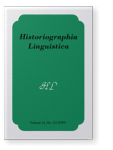La Doctrina y el Uso de Los Futuros en Las Gramáticas Renacentistas
Spanish grammars written through the 16th and 17th centuries can be used and are to be used as primary sources for the history of the Spanish language. However, when it comes to write the history of the morphology and syntax laid down in them, the following distinctions must be made: the prescribed use or standard, the described uses, and the grammarian’s own written use. In this paper, these distinctions are applied to the history of the analytic future and the conditional tenses (cantar-clitic-he, cantar-clitic-hía), especially in the attempt to explain the loss of these forms in the first half of the 17th century. Nebrija defines the future and conditional tenses as periphrases of infinitive + haber; Correas defines them in the same way, but he does not identify easily the verb haber in the -ía ending of the conditional tense. Neither of them – nor the other grammarians who have been studied: the Anonymous of Lovaina of 1555 and 1559, Villalón, del Corro, Jiménez Patón, Tejeda, Juan de Luna – codify the analytic forms in the verbal paradigms; that means that they do not consider them standard or prescribed usage, although they use them themselves (written uses) and they put them down as examples or other speakers’ uses (described uses). But the written use lasts only until the end of the 17th century; Tejeda and Correas use the analytic forms only in examples (described uses). Taking into account that in the literary language analytic forms last until about 1650, it must be said that the language of the grammars abandons these forms approximately a quarter of a century earlier.These forms were bound to disappear, because of their defective nature and their restricted distribution, and also because they showed a word order (auxiliated + auxiliary), uncompatible with SVO languages. Grammars of the ‘Golden Century’ allow us to understand better their dissapearance right in the first quarter of the 17th century, because they report the full grammatiealization of haber as the only auxiliary verb of the compound tenses.
Article language: Spanish
References (23)
Referencias Bibliográficas
ALEC = Gonzalo Correas,
Arte de la Lengua Española Castellana Ed. de Emilio Alarcos García. (=
Anejo LVI de la Revista de Filología Española
.) Madrid: CSIC
1954.

Andrés-Suaréz, Irene
1994 El verbo español: Sistemas medievales y sistema clásico. Madrid: Gredos.

Binotti, Lucia
1995 La teoría del “Castellano Primitivo”: Nacionalismo y reflexión lingüística en el Renacimiento español. Münster: Nodus Publikationen.

Company, Concepción
1985 “
Los futuros en el español medieval. Sus orígenes y su evolución”.
Nueva Revista de Filología Hispánica 341.48–107.


Corro, Antonio del
1988[1586] Reglas gramaticales para aprender la lengua española y francesa. Ed. de
Lidio Nieto. Madrid: Arco Libros.

Eberenz, Rolf
1996 “
Castellano antiguo y español moderno: Reflexiones sobre la periodización en la historia de la lengua”.
Revista de Filología Española 711.79–106.


Fleischman, Suzanne
1982 The Future in Thought and Language: Diachronic evidence from Romance. Cambridge: Cambridge Univ. Press.

GC = Elio Antonio de Nebrija,
Gramática de la Lengua Castellana Ed. de Antonio Quilis, 3
a ed. Madrid: Centro de Estudios Ramón Areces
1989.

Girón Alconchel, José Luis
1996 “
Gramática histórica en las gramáticas del Siglo de Oro”.
Actas del III Congreso Internacional de Historia de la Lengua Española ed. por
A. Alonso González,
L. Castro Ramos,
B. Gutiérrez Rodilla y
J. A. Pascual Rodríguez, Vol. I1, 687–697. Madrid: Arco Libros/ Fundación Duques de Soria por la Asociación de Historia de la Lengua Española.

Kukenheim, Louis
1974[1932] Contributions à l’histoire de la grammaire italienne, espagnole et française à l’époque de la Renaissance. Utrecht: H & S Publishers.

Patón, Bartolomé Jiménez
1965[1614] Epítome de la ortografía latina y castellana. Instituciones de la gramática española. Ed. de
Antonio Quilis y
Juan M. Rozas. Madrid: CSIC.

London, G. H.
1961 “
Notas sobre el futuro y condicional indicativos en la obra de Alfonso X”.
Boletín de Filología Española 81.6–8.

Lovaina
1555 =
Vtil y breve institvtion para aprender los principios y fundamentos de la lengua Hespañola. Lovaina 1555. Ed. de
Antonio Roldan. Madrid: CSIC 1977.

Lovaina
1559 =
Gramática de la lengua vulgar de España, Lovaina, 1559. Ed. de
Rafael de Balbín y
Antonio Roldán. Madrid: CSIC 1966.

Luna
=
Arte breve, y/ compendiossal para aprender/ a leer, escreuir, pronunciar,/ y hablar la Lengua/ Española./ Compuesta por luan de Luna/ Español, Castellano, Interprete/ della en Londres. Empressa en Londres por
Iuan Guillermo 1623 (
Biblioteca Nacional, Madrid, Sg. 8880.) Sin numeración de páginas.

Ramajo Caño, Antonio
1987 Las gramáticas de la lengua castellana desde Nebrija a Correas. Salamanca: Ediciones de la Universidad de Salamanca.

Rossi, Teresa María
1975 “
Formas de futuro en un romanceamiento bíblico del siglo XIII”.
Zeitschrift für romanische Philologie 911.386–402.


Sáez Godoy, Leopoldo
1968 “
Algunas observaciones sobre la expresión del futuro en español”.
Actas del XI Congreso Internacional de Lingüística y Filología Románicas ed. de
Antonio Quilis, vol. IV1 1875–1890 Madrid: CSIC.

Schede, Hildegard
1987 Die Morphologie des Verbes im Altspanischen. Frankfurt/Main: Peter Lang.

Tejeda
=
Jerónimo de Texeda.
Gramática de la lengua española Ed. de Juan Manuel Lope Blanch. México: UNAM
1979.

Valdés, Juan de
1984[1535] Diálogo de la lengua. Ed. de
Antonio Quilis. Barcelona: Plaza & Janés.

Villalón
=
Gramática Castellana For el Licenciado Villalón Ed. de Constantino García. Madrid: CSIC
1971.

Vincent, Nigel
1987 “
The Interaction of Periphrasis and Inflection: Some Romance Examples”.
Historical Development of Auxiliaries ed. de
Martin Harris y
Paolo Ramat, 237–256. Berlín: Mouton de Gruyter.


Cited by (1)
Cited by 1 other publications
This list is based on CrossRef data as of 3 july 2024. Please note that it may not be complete. Sources presented here have been supplied by the respective publishers.
Any errors therein should be reported to them.
